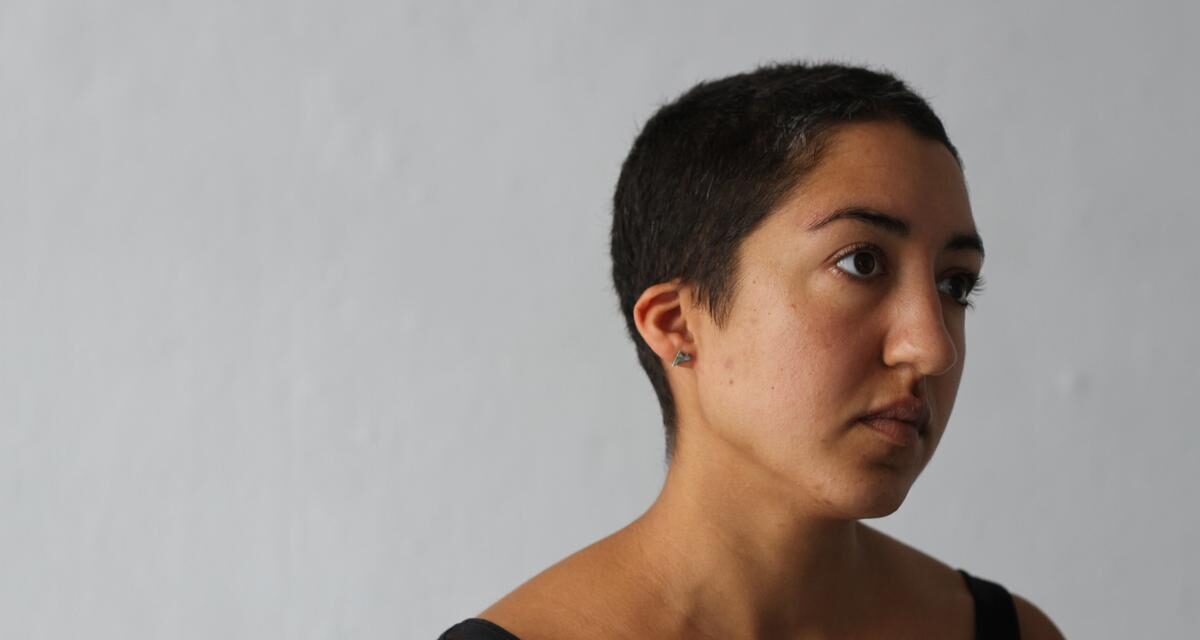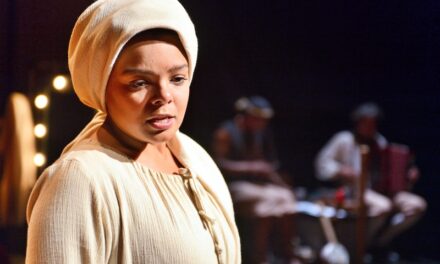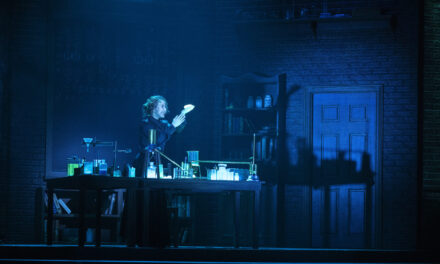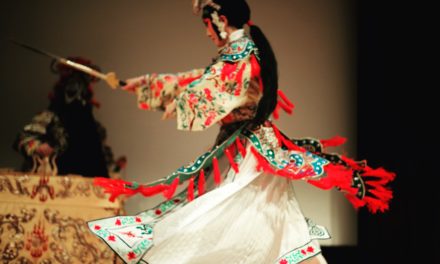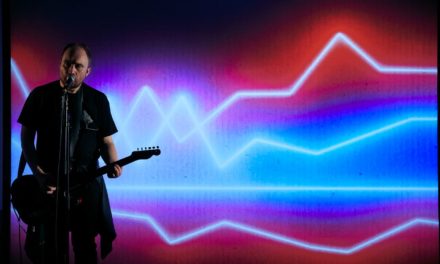Hvor kommer du fra? Hvor kommer du fra? Hvor kommer du fra? Hvor kommer du fra?
I have probably asked and practiced to ask this question about a zillion times over the last few weeks, during my first Danish language classes. The question comes across as timid, nice, and non-threatening. However, as the Danish playwright Helene Grøn has recently captured in an article in the Scottish Journal of Performance about her work with a group of rejected asylum seekers in the Deportation Centre Sjælsmark, the question bears an acute violence known only to some. To ask, “Where are you from?” is one of the first few lessons in almost every kind of language learning class.
“Hvor kommer du fra?” is only one of the uncomfortable lines early on in the performance script Break, which I had the pleasure to peak into and play with as a participant. The performance by Monia Sander Haj-Mohamed is part of the Afgang exhibition at Kunsthal Charlottenborg. In 2019, Sander Haj-Mohamed was awarded the Schade Literature Prize for her work Alexandertrilogien (2019), a performance essay, which deals with the process of falling in love, theatricality, and role-playing. Her previous work Dominique (2015) is a multimedia artwork, including poetics, prose, photography, playwriting, interviews, legal texts, videos, and installations. By engaging with the different materials, readers and audiences could dive into the complex mirroring between the literary figure of the window mannequin Dominique and the author herself, dealing with forms of mental health diagnosis and destabilizing medical models of mental divergence from a feminist perspective.
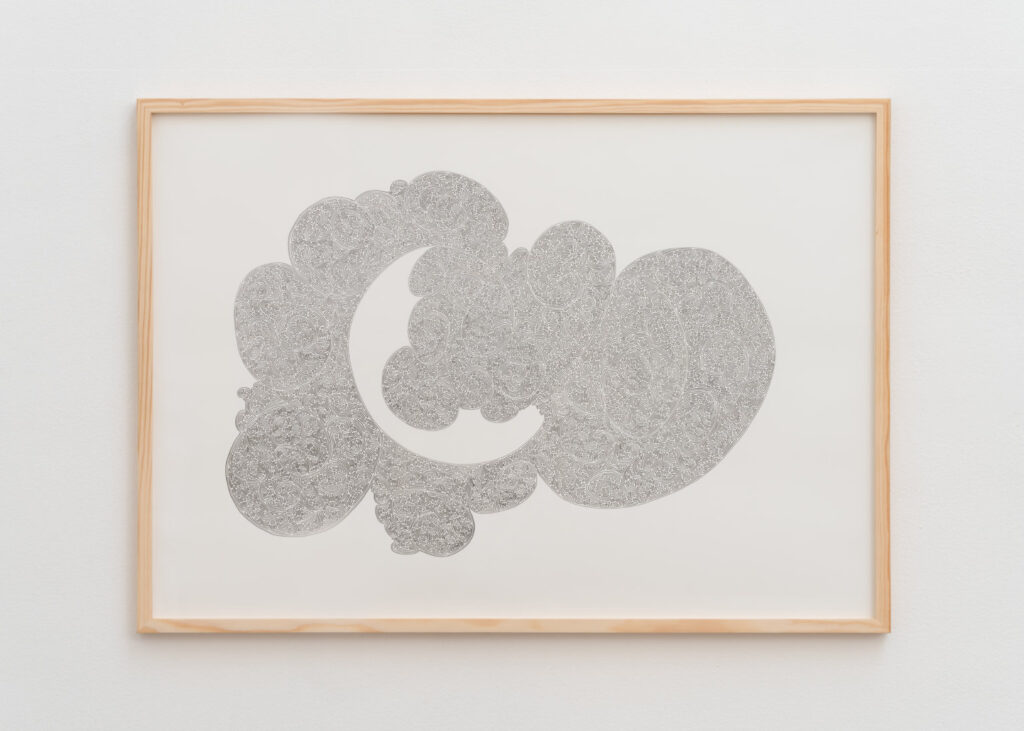
Drawing by Monia Sanders Haj-Mohamed, photo by David Stjernholm for the Afgang exhibition at Kunsthal Charlottenborg, Denmark, 2020.
In her previous works as well as in Break, Sander Haj-Mohamed approaches the performative space as one in between reality and fiction, between real people and literary characters. Her writing reminds one of Sarah Kane and Hélène Cixous. In the exhibition catalog about the performance Break, it says that for her, “the desire to create a performance is always a desire for healing.” She does not believe in therapy as an individual enterprise, but that most problems are social and can only be solved through an interaction between the personal and the collective. She draws, writes, and works between being awake and asleep, during this slippery, transitional passage in between the conscious and subconscious, where the ego goes to rest and something different emerges.
The performance Break takes place amidst Sander Haj-Mohamed’s visual artworks: 1) Malplaquetstraße 25, 13347 Berlin, 2/7-3/7 2018 and 2) Malplaquetstraße 25, 13347 Berlin 5/7-6/7 2018. Each of the drawings shows a continuous, circular line made by a rose or grey pen on paper, which forms overall into organic, round shapes like meticulous labyrinths. From afar, the overall shapes remind me of the promising (or frustrating) objects formed in the New Year’s tradition of lead-pouring, practiced in some European countries. In front of the exhibited drawings, there is a circle of ten black, wooden, bleak chairs. A flimsy, thin, white mask made of plaster lies on one of the chairs.
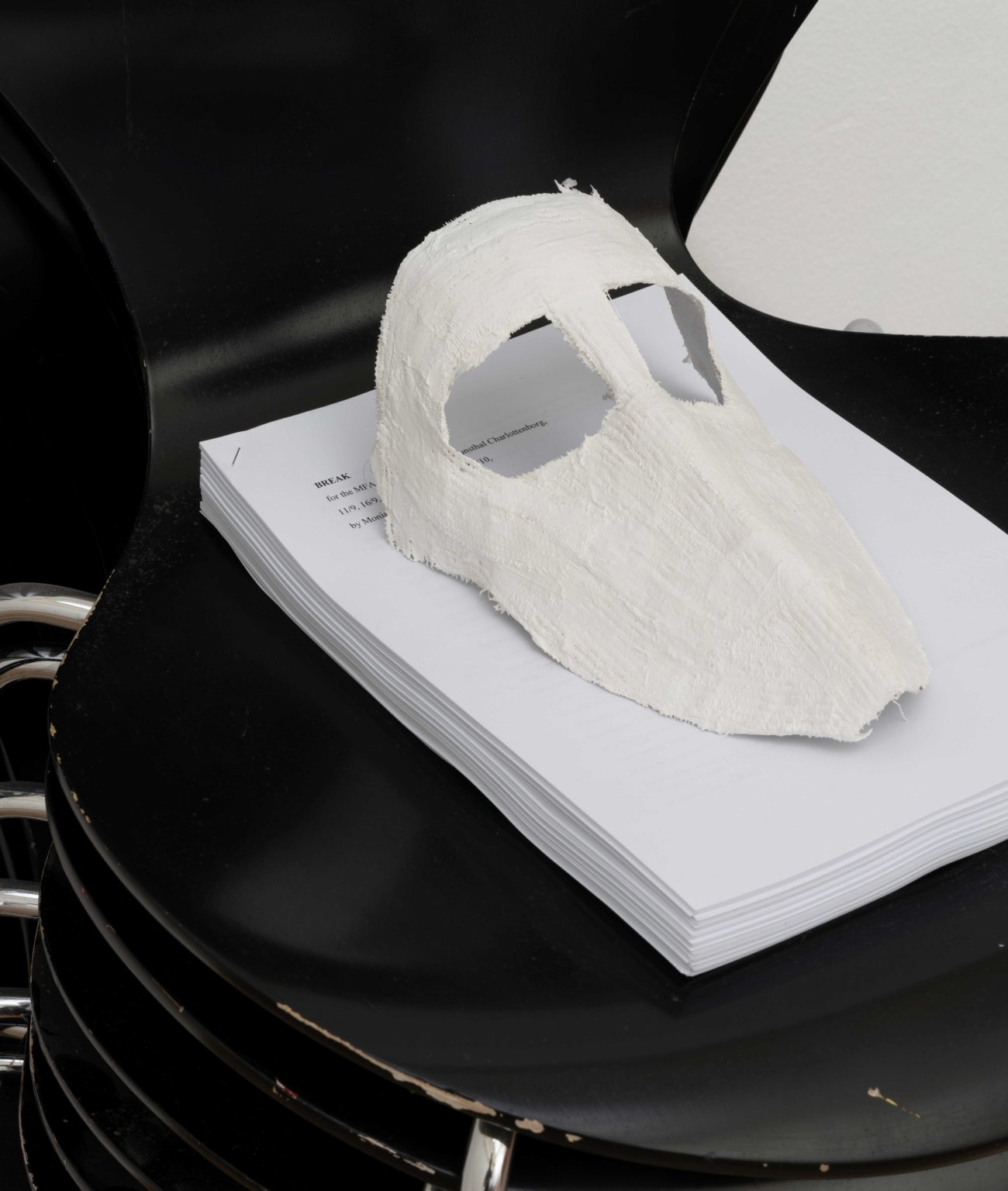
Photo by David Stjernholm for the Afgang exhibition at Kunsthal Charlottenborg, Denmark, 2020.
The nine participants quietly take place on the chairs and wait. Perhaps one of them, a cheerful theatre scholar starts chatting to break the ice. Some minutes pass. Then, the artist walks in. Head held high, offering an embracing, open atmosphere, yet keeping a somewhat neutral face–a knowing face. In her arms, she clutches a stack of ten scripts. Gently, she removes the plaster mask from one of the chairs, places it beneath it, sits down and breathes. Going in the round, she acknowledges and looks at every participant, while handing each of us a script. She quietly sits down again and says nothing. We say nothing, we wait. We wait and wonder.
There are two characters in the script: M. and the Spectator. In the performance, there is Sander Haj-Mohamed and nine audience members. Throughout the script, M. never has a spoken line, only one single, repeated stage direction, which directs her to remain silent. Sander Haj-Mohamed follows and performs exactly that. However, her inaction – or rather: her silent action – speaks volumes. In the round, the intimate group of spectators wait and sit quietly, too.
I enjoy this performance’s beginning. I am curious about Sander Haj-Mohamed and the other members, more than I am curious about what is written in the script. I am thinking: are they waiting for a cue? I observe the space and bodies, gestures, nervous smiles, raised eyebrows, clutched hands, fingers skimming the script pages. Maybe someone is building up the courage to speak and read a first line out loud? In silence, we contemplate and try figuring out the “rules” of this performance. Slowly, one audience member clumsily starts reading the first line in the script. We listen expectantly. Who might go next? What are we doing here? What is this atmosphere? Followed literally, the script only means for the spectators to read, speak, act out lines, and for M. to sit quietly and say nothing. In so doing, the spectators in the script are but giving M. a “break” from having to explain herself. Following the script, we ask where she comes from, how she identifies, what her stance is on specific identity politics, responding to whether/if/when she is seen as victim or as perpetrator and/or terrorist. Either or. Yet, Sander Haj-Mohamed in the role of M., as she has scripted it herself, sits there silently and endures our gush of read lines directed at her.
The scripted spectator lines build up a dramaturgy, where some spectators become increasingly angry at M. for not speaking, frustrated by not knowing what is going on, causing them to accuse her of manipulating the spectators while using racist slurs and hate speech against her. When we get to these lines, there is a moment, which crucially destabilizes the group atmosphere. We wait and wonder who is going to actually read these lines. Can we just jump ahead and skip reading these out loud? The script got me, and instead of remembering lines, I am drawn to my own thoughts and memories, a kind of “theatre of the mind” in the words of Martin Esslin. One white audience member shows her discomfort when stammering the scripted racial slurs directed at M., turning her gaze and head toward the silent performer Sander Haj-Mohamed. Her voice is shaking, her tone alienating, which seemingly helps to distance herself, her “authentic voice,” from the role of the Spectator. However, this supposedly “safe theatrical frame” is the point and crux of the actual real encounter between all of us, including Sander Haj-Mohamed. Break raises important questions about the affective, emotional, and political boundaries between spectators and performer in the theatre, which have wider implications for how we think about cultural virtue, pleasure, ally-ship, and anti-racist practices outside of the theatre, too.
Soon, the scripted conversation starts to label M.’s identity and envisions her lived experiences of racism. It is important here to stress that race is a social-historic construct or what Stuart Hall has termed a “floating signifier,” which means that skin color has meaning in culture and this meaning changes with the context, there is nothing essential or biological to it. The script talks about racist violence on different scales and scopes: systemic and institutional racism, including e.g. the militarisation of the European border regime and the radicalization of cleaners and their socio-economic position in our predominantly white societies, evictions, hate crimes, and hate speech, as well as everyday micro-aggressions.
There are also some quirky, witty and easing moments in the script, a dynamic back-and-forth and code-switching, which unfortunately got lost in the stuck, slow-paced and hesitant reading amidst the group I participated in. We never developed the dynamic the script might have needed to come alive fully. To me, the reading felt much more like pulling teeth, albeit in a productive way.
In my position as white, German citizen resident in Denmark and able-bodied cis-female fluent in three colonial languages, I noticed and wrestled with my growing frustration during the performance. I did and did not want us to behave like compliant spectators. I wanted to enjoy reading the scripted lines and play with them, rather than hesitating and caring for every single word on it. Having decidedly chosen to go and participate in what is described as a “not necessarily safe and comfortable” participatory performance, my expectations were high. I wanted to feel uncomfortable and be challenged. Ann-Christine Simke has analyzed that this need to work through feelings of white guilt actually speaks of my racialized white desire for a cathartic absolution, to come out of the theatre as a bettered, less guilty, and less racist white person. Ha. My growing frustration stems exactly from this: my problematic desire for feeling better(ed) after going to the theatre.
Rightly so, Sander Haj-Mohamed demands that I, and other audience members, navigate a complex set of emotions and privilege, performance anxieties, and immaterial labor within a wider neoliberal service economy. As Fintan Walsh has summarised in a different context: “We are not just here to see, think, and freely feel, but to work effectively. If we do not engage in this labor, the performance won’t happen. We fail the performance, we fail [the artist] […] we might also take heart at participants’ readiness to support and sustain the performance event” (quoted from “Touching, flirting, whispering: performing intimacy in public”, The Drama Review 58(4) p. 59).
At the end of the performance Break, once we had read our the final lines, M. once again followed the final stage directions; standing up, collecting the scripts from us and leaving the space, leaving us behind. After a long pause, some of us quietly laughed, feeling relieved or a bit betwixt; some of us clapped quietly. None of my fellow audience members left, we felt like staying seated for much longer, continuing to be with each other and share the experience of what we just did together, how we felt and what we thought. One person, and as I later learned, a dear friend of M., shared feeling torn between her discomfort and unwillingness to say the racial slurs in the script, but also wanting to “please the artist.” Theatre scholar Kirsty Sedgman has written about such an “audience-centered ethics of care” and the importance for audience members to feel as though their co-spectators care about the performance, about the shared experience and about theatre as such.

Photo by Aïcha Salamander for the Afgang exhibition at Kunsthal Charlottenborg, Denmark, 2020.
In the particular case of Break, I argue that the desire “to please” the racially marked artist, which is being expressed here by a white, female-identifying audience member, uncovers some more substantial, internalized racism. Perhaps the desire here speaks of both an ethics of care, but also of some sort of white “savior” complex, longing to comply with the artist, have her make the rules, and longing to inverse these cultural privileges and dependencies to give away responsibilities. “I wanted to please the artist” here then speaks to both the socio-political dispositions outside the presumed safe space of any theatrical frame, as well as to theatre’s problematic position as an often celebrated catalyst for “giving voice” in contemporary, white Western culture. Lastly, of course, the introjected behavior, “the ought to” please and be a dutiful audience member, is also entangled with societal gender norms and power relations which long precede the performance moment.
Break is a very elegant, very personal, carefully not-choreographed, and minimalist performance, in which Sander Haj-Mohamed does an awful lot by holding her silence, holding gazes, and holding the space. In so doing, she quietly and openly invites audiences to join in the theatrical conversation from whichever point they are in their anti-racist journeys. The performance is about witnessing Sander Haj-Mohamed’s storytelling craft – as well as about the impossibility and violence of witnessing. The performance is carried by Sander Haj-Mohamed’s bodily presence and energy, which makes it possible for us audiences to consider ways of how we are bound to each other, politically, emotionally, with complex desires and anxieties. We depend on another in the continuous pursuit of a radically just, anti-racist future and we depend on performative encounters in envisioning, rehearsing, and enacting such a future. Not in this performance, but some other times, we also depend on the theatre to simply give some of us a well-deserved break.
This article was originally posted at Peripeti.dk and has been reposted with permission. To read the original article, click here.
This post was written by the author in their personal capacity.The opinions expressed in this article are the author’s own and do not reflect the view of The Theatre Times, their staff or collaborators.
This post was written by Af Anika Marschall.
The views expressed here belong to the author and do not necessarily reflect our views and opinions.

